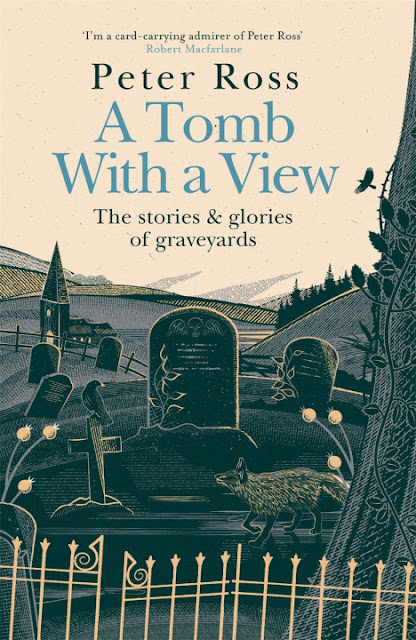Graveyards
themselves are essentially colons: they can introduce a narrative. Graveyards
are opportunities for storytelling, for understanding who these people were and
who we are.
Peter Ross in an interview for the Times
“I grew up in Graveyards. The dead were my babysitters, my quiet companions.”; Peter Ross opens his new book as though he is the protagonist of a novel by Neil Gaiman. In reality the award-winning Scottish journalist grew up in a house just like the rest of us though the house he lived in seems to have been a stone’s throw away from Stirling Old Town Cemetery where as a callow youth he went fishing for tadpoles or admiring the view across the city from an outcrop called Ladies’ Rock. To Ross graves were, and are “shelves full of stories”. Perhaps unsurprisingly the first living person in his new book is the ubiquitous Sheldon K. Goodman, who tells Ross “burial grounds are like libraries of the dead, indexes to lives long gone.” I have a good deal of sympathy for that view; it is pretty much my own attitude towards cemeteries. For all our professions of lifelong fascination with cemeteries the truth is that 20 years ago graveyards were a bit of a niche interest and hardcore taphophiles were rare creatures indeed. Cemetery books were published infrequently and cemeteries themselves were often lost and abandoned places. Graveyards have become fascinating in the age of the internet because on-line newspaper archives and genealogical sites make research of cemetery occupants much easier to do. And with their several million occupants UK burial grounds provide enough raw research material to keep bloggers and writers busy for at least another couple of hundred years. Is taphophilia the new trainspotting?
 |
| The author in his element - Peter Ross in Greyfriars Kirkyard, photo by James Glossop for The Times |
Ross’
book is a collection of journalistic short pieces on cemeteries in the UK and
Ireland. He visits burial places in London, (Brompton for Sheldon’s Queerly
Departed tour, Highgate, and Kensal Green), looks at Milltown cemetery in Belfast
and its intimate connection with the troubles, visits the grave of Phoebe
Hessel, the Stepney Amazon at St Nicholas in Brighton and Peter the Wild Boy in
Hertfordshire, war graves on the Scottish Islands and attends a wedding at
Arnos Grove cemetery in Bristol. At
Kensal Green he clears up a mystery that has puzzled me the last couple of
years when he meets Mehdi Mehra, an Iranian businessman who built an extraordinary
memorial to his eleven-year-old son Medi, who died in a riding accident. “Around
his son’s grave,” Ross says, “he built a memorial on a scale the Victorians
would recognise.” This is something of an understatement – the memorial is so
huge it dwarfs everything else in the cemetery. It is so large it isn’t even
immediately recognisable as a memorial. A 30-metre-long half circle of Corinthian
columns built using 350 tonnes of granite, 150 tonnes of steel and 200 tons of concrete and decorated with angels holding torches, books and flowers, this is monument on a
scale the Ancient Egyptians would recognise rather than the Victorians. At
Glasnevin cemetery we hear the harrowing story of charismatic tour guide Shane Mac Thomáis who became an unexpected celebrity after
appearing in a documentary about the cemetery One Million Dubliners. On
March 19 2014 CCTV cameras captured Mac Thomáis entering the cemetery at 7.00 in the
evening. Walking towards the main part of the cemetery he paused, turned around and
saluted the camera. His body was found hanging from a tree next morning. His
grave is now almost as big a draw at the cemetery as that of Michael Collins.
Ross
is a good writer; this could so easily have felt like a collection of newspaper
features loosely connected by theme but it doesn’t. The book is as concerned
with the living as it is with the dead (something for which it has been
criticised!) but the exploration of what draws the living to the dead is what
in the end elevates this above similar offerings on the same subject. It is
extremely readable, very polished and definitely highly recommended.
 |
| Kensal Green - the 'Belgravia of death'. |

No comments:
Post a Comment